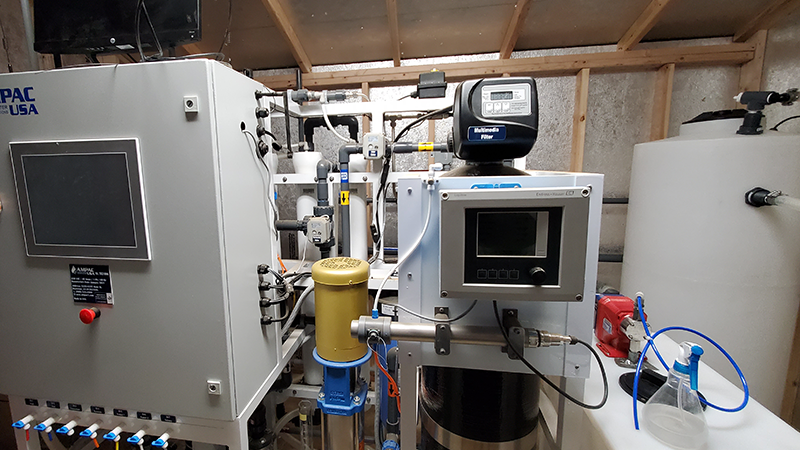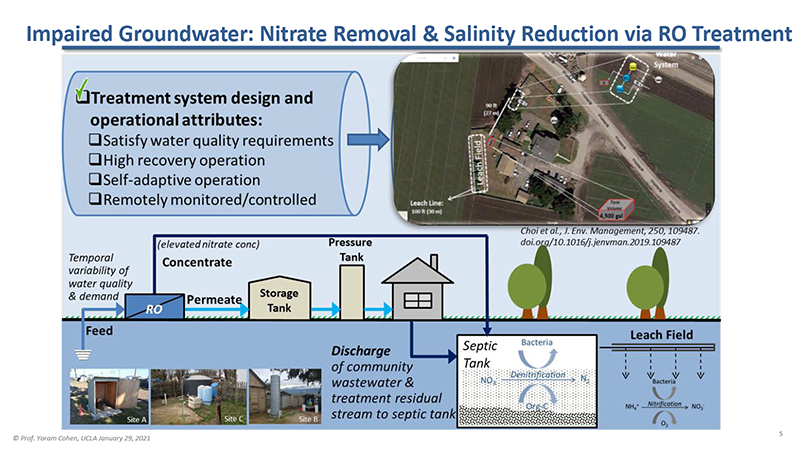UCLA Engineers Build Water Treatment System for Disadvantaged Communities

Courtesy of Yoram Cohen
Salinas Valley distributed water treatment project
California’s Salinas Valley is one of the most productive agricultural regions in the U.S., growing lettuce and many varieties of leafy greens, strawberries, wine grapes, garlic and more. But for isolated communities of farmworkers and others who live outside the reach of a municipal water system, access to clean drinking water has been an ongoing challenge.
Groundwater taken straight from a well is oftentimes too contaminated to drink, so water for drinking needs to be trucked in or provided as bottled water, and both are expensive and unsustainable as permanent solutions.
To solve this problem and provide an affordable and sustainable solution, veteran water technologies expert Yoram Cohen at the UCLA Samueli School of Engineering and colleagues from across campus have been working for more than two years to build and operate an on-site system that delivers safe, affordable drinking water to three small communities in the region.
The first of three water treatment systems, the pilot project to demonstrate the system’s long-term viability serves an 11-unit apartment complex on the outskirts of Salinas. The system started operating in August 2020 and has delivered clean water since coming online. Two more similarly sized communities farther south, outside the small town of Soledad, are in line to have UCLA water systems up and running in a matter of months. Following successful operations, the systems’ continued management will then be handed off to public or private agencies.

The project was supported by a $2.5 million grant from the California State Water Resources Control Board’s cleanup and abatement program. Other UCLA staff and students on the project include co-principal investigators Madelyn Glickfeld, the co-director of the UCLA Water Resources Group at the Institute of the Environment and Sustainability, assistant researcher Jin Yong Choi; graduate students Yeunha Kim and Yian Chen and undergraduate students Christian Aguilar and Mitchell Rogers. The team also includes Maria Kennedy, an independent consultant who serves as the project’s community liaison. Former team members include assistant researchers Bilal Khan and Anditya Rahardianto, and graduate students Tae Lee and Abdullah Alidain.
Cohen, a distinguished professor of chemical and biomolecular engineering at UCLA Samueli, recently shared his thoughts in the Q&A below about the unreliable water in the region and what he intends to accomplish with the UCLA developed and deployed distributed water treatment systems.
Q: What is in the water in the Salinas Valley region that makes it unsafe to drink?
Yoram Cohen: The water is high in salinity — above the recommended drinking water limit of about 500 milligrams per liter of total dissolved solids. Moreover, the water contains nitrate at about five times above the maximum allowable limits. This situation is not surprising in agricultural communities, where nitrates found in fertilizers or septic tanks can leach into groundwater. Nitrate is a contaminant that at high levels can weaken the blood’s ability to carry oxygen. It is a particular concern for infants and pregnant women.
Q: How does this system clean the water and make it safe enough for drinking?
Cohen: We provide in the range of 800 to 2,400 gallons of safe drinking water each day. The system utilizes a series of filtration steps — microfiltration, sand filters and reverse osmosis membranes — to remove nitrates and other contaminants, in addition to reducing the salinity of the brackish and impaired local well water. The water is then re-mineralized and disinfected before it’s delivered to the residents. We maintain local storage of drinking water that can last for two to three days, allowing for potential emergency measures. The residual stream from the treatment system is discharged to the community septic tank where denitrification of the utilized groundwater takes place under anaerobic conditions.
Q: The system is also being remotely operated. How does that work? Who oversees that? And what is the advantage in that?
Cohen: Remote monitoring, asset management and operation are the big keys to the project.
Basically, the treatment system has a local controller and embedded computer. Sensors that check water quality relay that information to a cloud server, along with information about the status of all valves and pumps, which we are able to control remotely. Moreover, we monitor the data via a web dashboard that enables monitoring and visualization of real-time data as well as historical data. We monitor and control the entire system via a desktop or tablet. There are also built-in alarms that can be triggered based on operational thresholds. Information about system status is automatically transmitted by email or text to the UCLA-based system management and monitoring team. We train and qualify researchers, who have been working on this project for some time, as California state-certified water treatment operators. In addition, we have contracted with an outside water system and water treatment technician to assist our UCLA team.
Q: Could this be a viable solution for other places in the state?
Cohen: Absolutely. The solution is ideal for remote communities that are not part of a centralized infrastructure and rely on their local groundwater for potable water supply. The key to this project has been the willingness of the local residents to work with the UCLA team, as well as buy-ins from local regulatory agencies that needed to approve the project. These communities do not have access to a centralized water system and for years have not been able to drink their local well water. Their reliance on subsidized bottled water is unsustainable and much more expensive compared to the monthly treatment system operating cost per residential unit, which is about $40. However, it should be noted that this estimated cost does not include the high costs associated with research and development, planning, legal fees, permits and regulatory compliance. Given these added fees, disadvantaged communities that lack safe drinking water would require government assistance both in terms of subsidies and technical and legal assistance.
Cohen has made a recent public presentation on the project available here.
